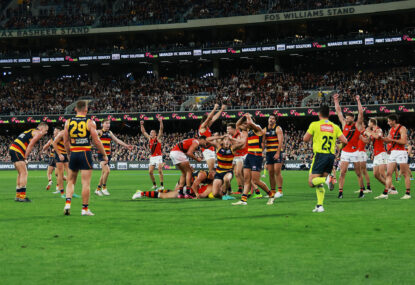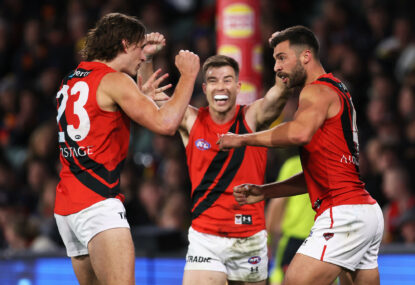Former Western Bulldog captain Brad Johnson provided food for thought in his article entitled ‘AFL doping just doesn’t make sense‘.
The premise was that performance enhancing drugs were of little value to elite footballers.
His argument was that synthetic boosters would not help participants to read the play better, run to the right spots to get a kick, help players strike the ball cleanly, hit targets or give them clean hands under pressure.
And he is right. These are the requisite skills required to play the game successfully, not only at the elite level, but at any level, and they can’t be improved by artificial means.
But what if you already possessed these skills? Would performance enhancing substances be of any benefit to you then?
To the absolute superstars of the sport, probably not. The elite of the elite would be great players regardless. But to the midrange players, the benefits could be the difference between securing that next contract or finding yourself back in one of the state leagues.
Let’s use the example of a solid, but not brilliant midfielder. He goes about his business with a minimum of fuss, collecting a commendable but hardly headline-grabbing 25 possessions a game. He reads the game well, but a lack of pace sees him beaten to several contests per game. His natural endurance is also below that of his teammates and he fails to run out each quarter as strongly as he should.
“Pssst, pssst.”
A whispered conversation with a teammate/coach/sports scientist/bikie gang member (you get the idea) and a mystery substance is produced. The player gives it a go.
A season later sees the player in question getting to more contests and running games out strongly. He is picking up two or three more possessions per quarter. It doesn’t sound like much, but all of a sudden this solid, 25 possession per game midfielder now averages 35 possessions per game and has become a Brownlow medal contender.
And what of that lanky key position player who kicks his three goals every week but gets bustled out of contested marking contests too easily? He has good hands, can read the ball in flight, but just lacks the strength to hold his position within a pack.
“Pssst, pssst.”
A season later he’s taking two or three contested marks per game, which gives him an extra couple of shots at goal each week. He goes from a 60 goal per year forward to an 80 goal per year forward.
Simplistic? Perhaps, but it illustrates what could happen.
Brad Johnson is right. Performance enhancing drugs can’t turn dud footballers into superstars – but they could make good players better.
Of more concern though seems to be the use of ‘supplements’ to aid recovery. Such are the demands placed on league footballers today, that much of their mid-week training focuses on recovery. While the buck stops with the clubs themselves, the AFL must take some responsibility for this worrying trend.
With games being increasingly scheduled across almost every day of the week, it is inevitable that teams, at some stage of the season, will have to back up for matches after only minimal rest.
Essendon was in the news again yesterday for that very reason. Due to its mid-week ANZAC Day clash against Collingwood last year, the Bombers ended up playing three games in just 11 days, including only a four day turnaround between its 30 point win against Carlton on April 21 and its one point loss to Collingwood on April 25.
A call for further investigation into the club’s recovery methods during this time has turned the spotlight onto its maligned sports science department once again.
Heavy workloads are not uncommon in the AFL and getting the recovery right can be the difference between having a good season or a mediocre one. It is something clubs have wrestled with for years.
Even the great coaches have got it horribly wrong at times.
In the early 80s, Kevin Sheedy was renowned for his physically draining training sessions. His Bombers were a promising team and, by 1983, were on the way to fulfilling their potential.
They made the grand final, but Sheedy had flogged them on the track and they turned up to that game dead on their feet. History shows they were beaten by a then record margin by arch rival Hawthorn.
But Sheedy learnt from his mistakes. He adapted. The Bombers bounced back to take the 1984 and 85 premierships with a team of fit and versatile young men.
The game has come a long way since those simple days of the 1980s. The demands the game makes on its players have increased tenfold. But the wheel turns and things will change again.
Coaches, training staff and players will adapt. The AFL, obsessed for so long about speeding up the game, and spreading its wings across not only the continent, but across the airwaves so that its product is visible almost every day of the week, may have to take a backward step.
The clubs have tried to counter the increase in stress placed upon their players. They developed a method of mass rotations from the interchange bench in a bid to keep their prime movers fresh, but were stymied by the AFL who thought it unsightly.
So it is hardly surprising that clubs have looked outside the square in an effort to decrease recovery time.
And while no concrete evidence has been put forward that Essendon or any other club have actually done anything wrong, the fallout from the pressure to succeed week in, week out in what is essentially a cutthroat competition, has only just begun.



































































































